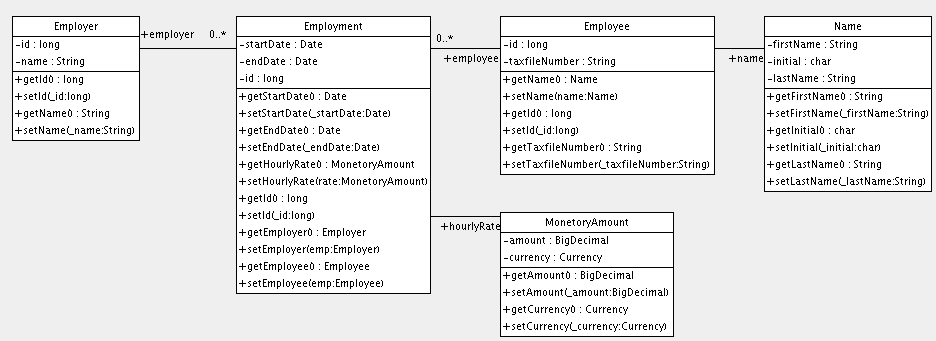Este conteúdo não está disponível no idioma selecionado.
Chapter 23. Various Mappings Example
23.1. Employer/Employee
Copiar o linkLink copiado para a área de transferência!
The following model of the relationship between
Employer and Employee uses an entity class (Employment) to represent the association. You can do this when there might be more than one period of employment for the same two parties. Components are used to model monetary values and employee names.
Here is a possible mapping document:
<hibernate-mapping>
<class name="Employer" table="employers">
<id name="id">
<generator class="sequence">
<param name="sequence">employer_id_seq</param>
</generator>
</id>
<property name="name"/>
</class>
<class name="Employment" table="employment_periods">
<id name="id">
<generator class="sequence">
<param name="sequence">employment_id_seq</param>
</generator>
</id>
<property name="startDate" column="start_date"/>
<property name="endDate" column="end_date"/>
<component name="hourlyRate" class="MonetaryAmount">
<property name="amount">
<column name="hourly_rate" sql-type="NUMERIC(12, 2)"/>
</property>
<property name="currency" length="12"/>
</component>
<many-to-one name="employer" column="employer_id" not-null="true"/>
<many-to-one name="employee" column="employee_id" not-null="true"/>
</class>
<class name="Employee" table="employees">
<id name="id">
<generator class="sequence">
<param name="sequence">employee_id_seq</param>
</generator>
</id>
<property name="taxfileNumber"/>
<component name="name" class="Name">
<property name="firstName"/>
<property name="initial"/>
<property name="lastName"/>
</component>
</class>
</hibernate-mapping>
<hibernate-mapping>
<class name="Employer" table="employers">
<id name="id">
<generator class="sequence">
<param name="sequence">employer_id_seq</param>
</generator>
</id>
<property name="name"/>
</class>
<class name="Employment" table="employment_periods">
<id name="id">
<generator class="sequence">
<param name="sequence">employment_id_seq</param>
</generator>
</id>
<property name="startDate" column="start_date"/>
<property name="endDate" column="end_date"/>
<component name="hourlyRate" class="MonetaryAmount">
<property name="amount">
<column name="hourly_rate" sql-type="NUMERIC(12, 2)"/>
</property>
<property name="currency" length="12"/>
</component>
<many-to-one name="employer" column="employer_id" not-null="true"/>
<many-to-one name="employee" column="employee_id" not-null="true"/>
</class>
<class name="Employee" table="employees">
<id name="id">
<generator class="sequence">
<param name="sequence">employee_id_seq</param>
</generator>
</id>
<property name="taxfileNumber"/>
<component name="name" class="Name">
<property name="firstName"/>
<property name="initial"/>
<property name="lastName"/>
</component>
</class>
</hibernate-mapping>
Here is the table schema generated by
SchemaExport.
create table employers (
id BIGINT not null,
name VARCHAR(255),
primary key (id)
)
create table employment_periods (
id BIGINT not null,
hourly_rate NUMERIC(12, 2),
currency VARCHAR(12),
employee_id BIGINT not null,
employer_id BIGINT not null,
end_date TIMESTAMP,
start_date TIMESTAMP,
primary key (id)
)
create table employees (
id BIGINT not null,
firstName VARCHAR(255),
initial CHAR(1),
lastName VARCHAR(255),
taxfileNumber VARCHAR(255),
primary key (id)
)
alter table employment_periods
add constraint employment_periodsFK0 foreign key (employer_id) references employers
alter table employment_periods
add constraint employment_periodsFK1 foreign key (employee_id) references employees
create sequence employee_id_seq
create sequence employment_id_seq
create sequence employer_id_seq
create table employers (
id BIGINT not null,
name VARCHAR(255),
primary key (id)
)
create table employment_periods (
id BIGINT not null,
hourly_rate NUMERIC(12, 2),
currency VARCHAR(12),
employee_id BIGINT not null,
employer_id BIGINT not null,
end_date TIMESTAMP,
start_date TIMESTAMP,
primary key (id)
)
create table employees (
id BIGINT not null,
firstName VARCHAR(255),
initial CHAR(1),
lastName VARCHAR(255),
taxfileNumber VARCHAR(255),
primary key (id)
)
alter table employment_periods
add constraint employment_periodsFK0 foreign key (employer_id) references employers
alter table employment_periods
add constraint employment_periodsFK1 foreign key (employee_id) references employees
create sequence employee_id_seq
create sequence employment_id_seq
create sequence employer_id_seq